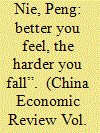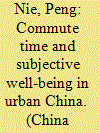|
|
|
Sort Order |
|
|
|
Items / Page
|
|
|
|
|
|
|
| Srl | Item |
| 1 |
ID:
187820


|
|
|
|
|
| Summary/Abstract |
The health risks of the current COVID-19 pandemic, together with the drastic mitigation measures taken in many affected nations, pose an obvious threat to public mental health. To assess predictors of poor mental health in the context of the COVID-19 pandemic, this study first implements survey-based measures of health perception biases among Chinese adults during the pandemic. Then, it analyzes their relation to three mental health outcomes: life satisfaction, happiness, and depression (as measured by the CES−D). We show that the health overconfidence displayed by approximately 30% of the survey respondents is a clear risk factor for mental health problems; it is a statistically significant predictor of depression and low levels of happiness and life satisfaction. We also document that these effects are stronger in regions that experienced higher numbers of confirmed COVID-19 cases and deaths. Our results offer clear guidelines for the implementation of effective interventions to temper health overconfidence, particularly in uncontrollable situations like the COVID-19 pandemic.
|
|
|
|
|
|
|
|
|
|
|
|
|
|
|
|
| 2 |
ID:
161817


|
|
|
|
|
| Summary/Abstract |
Using data from the 2010 China Family Panel Studies, this study investigates the association between commute time and subjective well-being in a sample of 16- to 65-year-old employees in urban China. We find evidence that a longer commute time is associated with lower levels of both life satisfaction and happiness, especially when the commute times are extreme (≥ 1 hour per day). A multiple mediation analysis further indicates that the relation between commute time and happiness is partially mediated by the time spent on daily activities, particularly sleep. We also calculate the amount of income necessary to compensate an employee's loss in well-being at approximately 82 yuan per hour of commute time, implying that in urban China the annual loss of well-being amounts to around 10 billion yuan.
|
|
|
|
|
|
|
|
|
|
|
|
|
|
|
|
| 3 |
ID:
192411


|
|
|
|
|
| Summary/Abstract |
Using longitudinal data from the 2014–2018 China Family Panel Studies, we investigate the impact of internet use (IU) on fertility among reproductive-age women. We find that IU reduces the number of children born, with more pronounced effects among those with a moderate level of education, those aged 16–19, rural residents, and those who are married. These results are robust to alternative IU measures and a series of estimation approaches that control for endogeneity. IU participation affects the number of children born through decreased marital satisfaction, changed attitudes toward traditional gender roles, a reduction in the importance placed on ancestral lines, deteriorated health and reduced fertility preferences.
|
|
|
|
|
|
|
|
|
|
|
|
|
|
|
|
| 4 |
ID:
143444


|
|
|
|
|
| Summary/Abstract |
Using several waves of the China Health and Nutrition Survey (CHNS), this study analyzes the effect of long work hours on health and lifestyles in a sample of 18- to 65-year-old Chinese workers. Although working long hours does significantly increase the probabilities of high blood pressure and poorer reported health, the effects are small. Also small are the negative effects of long work hours on sleep time, fat intake, and the probabilities of sports participation or watching TV. We find no positive association between work time and different measures of obesity and no evidence of any association with calorie intake, food preparation and cooking time, or the sedentary activities of reading, writing, or drawing. In general, after controlling for a rich set of covariates and unobserved individual heterogeneity, we find little evidence that long work hours affect either the health or lifestyles of Chinese workers.
|
|
|
|
|
|
|
|
|
|
|
|
|
|
|
|
| 5 |
ID:
170346


|
|
|
|
|
| Summary/Abstract |
Using data from the China Health and Nutrition Survey, this study analyses changes in bodyweight (body mass index and waist circumference) distributions between 1991 and 2011 among adults aged 20+ in China. To do so, we quantify the source and extent of temporal changes in bodyweight and then decompose the increase in obesity prevalence into two components: a rightward shift of the bodyweight distribution (mean growth) and a (re)distributional skewing. Our analysis reveals a clear rightward distributional shift combined with a leftward skewing. Although the relatively large size of this skewing in the first decade analysed reflects an increase in obesity inequality, this inequality growth subsides in the second decade. Nevertheless, over the entire 20-year period, obesity inequality increases significantly, especially among females, younger age groups, residents in rural and western provinces, and individuals with low socioeconomic status.
|
|
|
|
|
|
|
|
|
|
|
|
|
|
|
|
| 6 |
ID:
143388


|
|
|
|
|
| Summary/Abstract |
Using data from the China Health and Nutrition Survey (CHNS), this study analyzes peer effects on obesity in a sample of 3- to 18-year-old children and adolescents in China. Even after a rich set of covariates and unobserved individual heterogeneity are controlled for, it is evident that such peer effects do indeed exist. These effects are stronger in rural areas, among individuals at the upper end of the BMI distribution, and especially among females. All else being equal, female adolescents whose peers have a higher BMI are less likely to consider themselves overweight, suggesting that peer effects may be working through changed societal bodyweight norms.
|
|
|
|
|
|
|
|
|
|
|
|
|
|
|
|
|
|
|
|
|